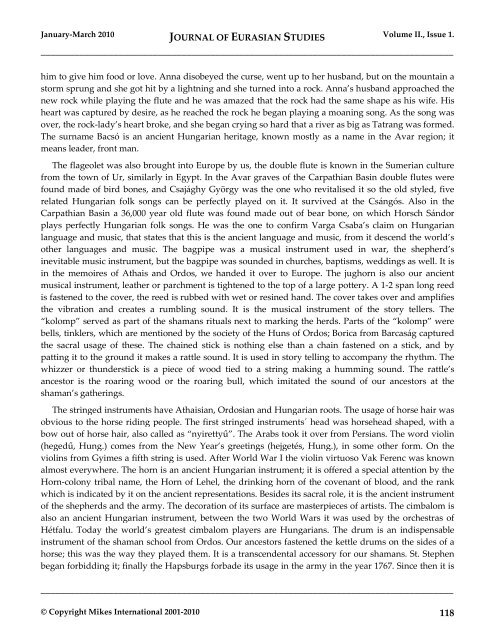EurasianStudies_0110..
EurasianStudies_0110..
EurasianStudies_0110..
Create successful ePaper yourself
Turn your PDF publications into a flip-book with our unique Google optimized e-Paper software.
January-March 2010 JOURNAL OF EURASIAN STUDIES Volume II., Issue 1.<br />
_____________________________________________________________________________________<br />
him to give him food or love. Anna disobeyed the curse, went up to her husband, but on the mountain a<br />
storm sprung and she got hit by a lightning and she turned into a rock. Anna’s husband approached the<br />
new rock while playing the flute and he was amazed that the rock had the same shape as his wife. His<br />
heart was captured by desire, as he reached the rock he began playing a moaning song. As the song was<br />
over, the rock-lady’s heart broke, and she began crying so hard that a river as big as Tatrang was formed.<br />
The surname Bacsó is an ancient Hungarian heritage, known mostly as a name in the Avar region; it<br />
means leader, front man.<br />
The flageolet was also brought into Europe by us, the double flute is known in the Sumerian culture<br />
from the town of Ur, similarly in Egypt. In the Avar graves of the Carpathian Basin double flutes were<br />
found made of bird bones, and Csajághy György was the one who revitalised it so the old styled, five<br />
related Hungarian folk songs can be perfectly played on it. It survived at the Csángós. Also in the<br />
Carpathian Basin a 36,000 year old flute was found made out of bear bone, on which Horsch Sándor<br />
plays perfectly Hungarian folk songs. He was the one to confirm Varga Csaba’s claim on Hungarian<br />
language and music, that states that this is the ancient language and music, from it descend the world’s<br />
other languages and music. The bagpipe was a musical instrument used in war, the shepherd’s<br />
inevitable music instrument, but the bagpipe was sounded in churches, baptisms, weddings as well. It is<br />
in the memoires of Athais and Ordos, we handed it over to Europe. The jughorn is also our ancient<br />
musical instrument, leather or parchment is tightened to the top of a large pottery. A 1-2 span long reed<br />
is fastened to the cover, the reed is rubbed with wet or resined hand. The cover takes over and amplifies<br />
the vibration and creates a rumbling sound. It is the musical instrument of the story tellers. The<br />
“kolomp” served as part of the shamans rituals next to marking the herds. Parts of the “kolomp” were<br />
bells, tinklers, which are mentioned by the society of the Huns of Ordos; Borica from Barcaság captured<br />
the sacral usage of these. The chained stick is nothing else than a chain fastened on a stick, and by<br />
patting it to the ground it makes a rattle sound. It is used in story telling to accompany the rhythm. The<br />
whizzer or thunderstick is a piece of wood tied to a string making a humming sound. The rattle’s<br />
ancestor is the roaring wood or the roaring bull, which imitated the sound of our ancestors at the<br />
shaman’s gatherings.<br />
The stringed instruments have Athaisian, Ordosian and Hungarian roots. The usage of horse hair was<br />
obvious to the horse riding people. The first stringed instruments´ head was horsehead shaped, with a<br />
bow out of horse hair, also called as “nyirettyű”. The Arabs took it over from Persians. The word violin<br />
(hegedű, Hung.) comes from the New Year’s greetings (hejgetés, Hung.), in some other form. On the<br />
violins from Gyimes a fifth string is used. After World War I the violin virtuoso Vak Ferenc was known<br />
almost everywhere. The horn is an ancient Hungarian instrument; it is offered a special attention by the<br />
Horn-colony tribal name, the Horn of Lehel, the drinking horn of the covenant of blood, and the rank<br />
which is indicated by it on the ancient representations. Besides its sacral role, it is the ancient instrument<br />
of the shepherds and the army. The decoration of its surface are masterpieces of artists. The cimbalom is<br />
also an ancient Hungarian instrument, between the two World Wars it was used by the orchestras of<br />
Hétfalu. Today the world’s greatest cimbalom players are Hungarians. The drum is an indispensable<br />
instrument of the shaman school from Ordos. Our ancestors fastened the kettle drums on the sides of a<br />
horse; this was the way they played them. It is a transcendental accessory for our shamans. St. Stephen<br />
began forbidding it; finally the Hapsburgs forbade its usage in the army in the year 1767. Since then it is<br />
_____________________________________________________________________________________<br />
© Copyright Mikes International 2001-2010 118

















